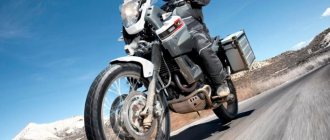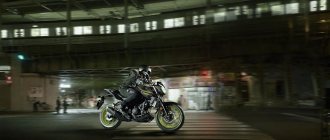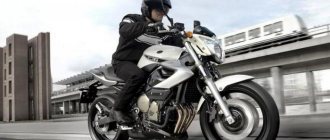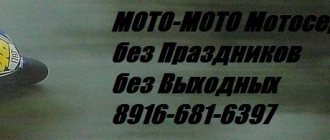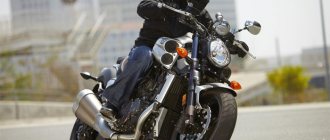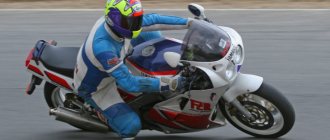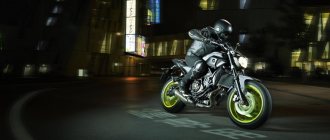Yamaha evolution
from Motorreview No. 2, 2004
Yamaha TDM 900: 897 cc, 190 kg, 86 hp, $11,000
Motorcycle breeders around the world have long been trying to raise a kind of two-wheeled beauty capable of giving exceptional pleasure from aerobatics. The components of the “recipe” are known: all the advantages of large enduro bikes, the dynamic qualities of sportbikes, the practicality of “tourists”, the rest is up to taste. At one time, in 1991, Yamaha was the first to offer a similar product - TDM 850. Then, in the process of evolution, it changed the percentage of certain components. By 2001, they finally managed to find their ideal ratio. The culmination of more than 10 years of selection was the Yamaha TDM 900. The success of the 850 cc version was obvious, but at the same time, over the years of its life, enough complaints and shortcomings had accumulated. In contrast to the new developments of competitors, they became more and more noticeable, and therefore in 2001 Yamaha decided to “work on the mistakes.” Fortunately, the canons of the style, which includes TDM, have already been established, and all that remained was to replace the morally “tired” units with more modern ones. Down with steel duplex, long live aluminum alloy - the structure has become lighter and more rigid. Most complaints about the "old" TDM were related to the lack of engine power.
The highlight of TDM has always been in the power unit. A rower with the character of a V-twin! And all because the pistons in the engine move parallel to each other with a delay of half a stroke, and the mixture ignites asymmetrically. All this together gave the car a special character. To lose it means to lose all the old admirers... It is not surprising that it was decided to follow the path of least resistance - to increase the cubic capacity and change the power system. Another 49 cm3 uphill, plus a modern injection system, and everyone is happy - there is an increase in power by 5% and torque by 11%. The dynamic qualities were affected by the replacement of the five-speed gearbox with a six-speed one with a “low” first stage and a “high long” last one.
The rather nice and modern appearance of the “old” TDM was transferred to the 900 cc version with minimal restyling. Still the same memorable eagle gaze of the head optics, a half-fairing cut like a sportbike, a high-raised “tail”... But despite all the general similarities, the ergonomics of the heir have changed. The seat was raised by 30 mm, the range of settings for the rear monoshock absorber was expanded, and the angle of inclination and length of the stays of the front fork were changed. The rear swingarm has become 40 mm longer, not to mention the fact that the engine is located more vertically in the chassis and slightly forward. Naturally, the brake systems were also strengthened - with brackets from the R1.
Time passes, and more and more 900 cc Yamaha beauties appear in our open spaces. Fortunately, there are areas here where the car’s road qualities are fully demonstrated. Most recently, as part of our column, our experts rode the TDM 850 (Motoreview, 10/2003). Now it is the turn of his heir. We deliberately did not spread them far apart in time. In contrast, it is always easier to taste the difference and features...
Vladimir Zdorov, Motor Review expert Height – 193 cm, driving experience – 13 years, rides a Suzuki TL1000R sportbike. Perhaps I was looking forward to this fitting with particular impatience. I've always liked TDM. At one time I even thought about buying it. But it didn’t work out. Testing the 850cc version, I was once again convinced that the design principle in aviation, which says: “What looks good should fly just as well,” is quite applicable to motorcycles. Indeed, after that long-ago test I have only positive memories. But life does not stand still. The “old lady” has long been asking for a well-deserved pension, and her competitors are not sleeping...
In general, it should be noted that the touring enduro market is clearly experiencing an increased boom from both the buyer and the manufacturer. Perhaps only the completely lazy did not throw their greedy little hands towards such a tasty pie. Judge for yourself: Aprilia gave birth to the Caponord model, and also released the Rally Raid modification. The gentlemen from BMW have already prepared an updated version of their extremely popular R1150GS in Germany. According to rumors, it should become the best in the class in terms of weight/power ratio. And there is no need to smile sarcastically, as if this whole country is slightly larger than the Moscow region. Therefore, Germany is the largest motorcycle market in Europe. Moreover, old “friends” from Suzuki also did not fail to kick the “old lady” TDM with a foot shod in a cross bot from Alpinestars size 47 - they threw a very interesting V-Strom onto the market. But there is also the Triumph Tiger, which, by the way, is also a worthy device. In such a very significant “tedaymka” a very unenviable role was prepared. But the situation was corrected by subsequent modernization.
The first thing that immediately catches your eye is that the model is still clearly recognizable, and that’s good. Looks at the world a little more “aggressively”. Why bother making eyes here - look how many rivals have multiplied! The seat height (825 mm) is quite low for motorcycles of this class. Naturally, I had no problems reaching the ground with my feet. And short riders will be very comfortable here, unlike the same Caponord. And the dry weight of 190 kg is the best in the class, and this is immediately noticeable in motion. I really liked the new gearbox. The “mushyness” of its predecessor has sunk into oblivion, and six steps for this kind of transcontinental express have long become the norm. After all, in theory, such motorcycles should spend most of their lives on the autobahn. However, this is still a long way from Honda’s standard “boxes”. And in general, in order to fairly objectively judge the performance and, most importantly, the reliability of the gearbox, long-term life tests are necessary.
The new engine has significantly improved its health. The difference is especially noticeable at speeds above 150 km/h. But the overall impression of the model is based not only on its dynamic characteristics. The center of gravity of the car has shifted forward. Now the handling of the device has become even closer to sportbike standards. With great desire and, perhaps more importantly, skill, turns “with the knee” are performed noticeably easier than on its predecessor. Along the way, my favorite wheelie effect disappeared, and, despite the increased power and torque, I still had to work harder to get this motorcycle to go in reverse from second gear. However, for the vast majority of users of this type of road bike, this is still a plus, not a minus...
I really liked the brake calipers, which were carried over here from the R1; they do their job superbly. However, after a series of vigorous decelerations from speeds of “slightly over 200”, the front brake lever clearly increased its travel, hinting that he was bored to death with a restless expert who behaved as if he were on some kind of sports bike, and that If such a driving style is evident, then it is necessary to install reinforced hoses... I also noted that during such simulations of sharp braking, the rigidity of the front fork is slightly lacking - the device begins to nod. Everything is relative though. It's not scary at all here. The motorcycle remains under complete control. As for the rear brake, the problem of very early locking of the rear wheel has successfully moved here from the old model. Alas, nothing has changed here for the better.
But what a new “tidy”. There is absolutely nothing to complain about, and finally there is a full-fledged fuel level indicator! The tachometer dominating the center clearly hints that the “sport” component here dominates the “tourer” component. And it is in this capacity, it seems to me, that the new 900 cc version should be considered. Would you like to drive one? Certainly! If only I could add about 50 more power to the engine... And a real V-twin is still better than its in-line and very reliable-sounding copy. It would also be nice to put a “shifter” in front. In general, there is no perfection in the world...
Leonid Yushkin, Motor Review expert Height - 186 cm, driving experience - 22 years, rides a Suzuki DR-Z400 His ancestor did not belong to any known motorcycle qualification, was a kind of outcast, and this one even more so. But if all sorts of big “parquet enduros” could talk almost on equal terms with that, then with the new TDM such a trick will no longer work. The dynamic capabilities of the car are comparable to those of a sportbike. I have always liked universal off-road rolling motorcycles, but I understand in my heart that asphalt “cruisers” like the TDM 900 are simply doomed to be popular in our country. You know, if you mentally imagine an image of a motorcycle for all occasions, your brain draws a picture of something very similar to a 900 cc modification. This is an almost “liter” engine, a lightweight aluminum frame, powerful and long-travel suspensions and, of course, almost sports brakes. A developed half-fairing is required. All this is included as standard on the TDM 900.
It's very comfortable behind the wheel. It feels like I came home and plopped down on my favorite sofa in front of the TV. The directional stability is excellent, the device is easily shifted in turns, and darts between cars with the skill of a nimble mouse. The engine is simply magnificent. I remember the 850 cc version suffered from some laziness and failures. There is smooth and powerful traction throughout the entire operating speed range.
Without noticing it, I found myself already outside the city, “rolling” along the highway between trucks at 200 km/h. I checked the brakes... Some part flew off the KAMAZ, and I had to avoid the collision. Then another extreme braking, and no signs of overheating. The force of the front brake is measured with one finger. The suspension setup was somewhat surprising. Well, definitely for the autobahns there. As soon as the smooth “crust” is replaced by a rough profile with numerous holes and pits in the asphalt, cottoniness appears in the “legs” of this “animal”. Coward! These are still flowers, after 200 kilometers we will have no roads at all according to your concepts... I took a ride along forest paths... In general, not bad: in the second and third gears, the “gas” easily regulates the rhythm of movement from almost snail-like to rapidly endursky. The only problem with the model’s ground clearance is that it doesn’t even have decorative protection. Just look, the pipes will press against the ground. Passengers will appreciate the wide “sofa”, which is called a seat. The only pity is that the heels will still sometimes touch the exhaust pipes. When traveling long distances, you can place a bunch of luggage in the back, and the most valuable things will fit in the trunk. There is also enough space for it.
Overall, a very good and beautiful motorcycle. The company managed to correct all the shortcomings of the “old” TDM and endow the model with new potential. Considering that such cars are bought by wealthy people and often as their first motorcycle, then I’m sure they will like it. For now, the average motorcyclist swallows his saliva and rides a TDM 850. And this device is not bad either.
Andrey Trifonov, columnist for Motor Review Height – 191 cm, driving experience – 10 years, drives a Suzuki GSF1200S Bandit I went last, having already heard a lot of enthusiastic responses about this car. Perhaps this moment changed my perception of the model. Because I prepared for one thing, but got something completely different. They told me: “TDM turned out to be really powerful!..” Hmmm... Where are these “mares”, if I’m not mistaken, almost 90 hp? Well, they are not there, brothers! My “bandit” seems like just a rocket after the Yamaha. The only thing the car has is traction at low and medium speeds. When you “start up” and want to get something sportbike-like, you see how the tachometer needle is already touching the red zone. Just for fun, I measured the approximate speed indicators. So, this “giraffe” goes from zero to “hundreds” in 3.5 seconds, and “flies” 400 meters in 12 seconds. The only thing that pleased me was the elasticity of the top gear - from 50 km/h to “hundreds” in it it accelerates in just over four seconds. I tried to find out the “maximum speed”, but at about 210 km/h the motorcycle “floated” above the road surface, and I no longer risked testing it and my fate. It seems that the designers completely strangled the engine for the sake of European “green” toxicity and noise standards. By the way, despite their volume and the already well-known almost “Wetvin” character, the mufflers “sing” very quietly. This is where tuning comes in...
Well, there are no complaints about the rigidity of the frame and rear swingarm. The base has become larger, the fork angle has increased to 25.5, something has been adjusted in the suspension, so the handling has also improved. He used to drive with the capabilities of a good road bike, but now he’s a good boy. It's like riding on rails! But, guys, again these Japanese screwed up the stiffness of the shock absorbers. How many times have we told them that the TDM 850 has a very soft front fork, and the rear monoshock could be stronger. And they are back to their old ways. Of course, I understand that the authors were primarily thinking about European tourists, but there are also advanced people among them. So, in the standard setting, driving fast in our directions is no way... From active work on potholes, the shock absorbers warm up and dampen vibrations noticeably worse. When my front almost gave way in a turn (it was a sin - I slowed down), at the first more or less convenient parking area I started to reconfigure. What smart guy made a special key for this? Firstly, it might not immediately occur to you that it is included in the standard set of tools. Secondly, only a stubborn person will climb into the depths somewhere and, with the groaning of an old grandfather, will clamp the spring. In general, I tightened the suspension to the maximum, but the end result did not delight me. Yes, the ride has become better, but not fundamentally.
About the brakes... They are from R1, and therefore I don’t think there’s any point in saying anything against them. But this is abstract, only about them. If you look at the problem comprehensively, then with such a weak and prone to dive fork, such powerful brakes at the front can be dangerous. The motorcycle really provokes active riding both in the city and beyond. The engine, chassis and brakes sometimes allow you to do unnecessary things. The front “telescope” hangs above all this like a sword of Damocles. And this is on a machine without any download. What will happen to the efficiency of the suspension if you load a couple of travel bags in the back and seat a well-fed friend?
Ergonomics and wind protection are good, but dirt and moisture flying from the wheel tend to cover all your limbs from toes to knees. The mirrors are quite well positioned in height and do not resonate at any engine operating mode. By the way, vibrations are almost not transmitted to the pilot’s body. It has long been a mystery to me why Yamaha has not yet learned how to make normal gearboxes. Again, as always, difficult searches for neutral, hard gear shifting. This should no longer be considered a disadvantage. You just need to remember that this is a proprietary feature of the company’s products. I would also immediately upgrade the light optics. Because driving such a handsome car with a “black eye” is not respectable.
Did I like the TDM 900? Yes and no. I don’t argue: comfortable, practical, dynamic. But at the same time: expensive, narrowly targeted, with a lot of problems. The last doubts disappeared when I rode the first 100 meters on my Suzuki GSF1200S Bandit. No, most likely not... No, definitely not...
Mikhail Lapshin, deputy editor-in-chief of Motorreview Height - 192 cm, driving experience - 12 years, rides a Honda CBR 600F As I already said, the TDM 850 is my favorite motorcycle. I accepted the offer to ride the “Next generation” with enthusiasm. I wanted to find the difference between these ages... Yes, he is completely different. Even in static conditions you understand this: the saddle is clearly higher, as is the steering wheel, the footpegs are “not there”, the sides are narrower, and in general everything is new. You can’t feel the engine pulsation at idle at all; when you turn the gas, the engine responds differently, more zealously, or something... The instrument panel has become clearly prettier (there is a clock and a fuel level indicator), but in general the design is already outdated. No modern effects for you, everything is simple but functional.
The power has actually increased. Thanks to the fuel injection system and the new engine characteristics, the traction is smooth and confident even from the bottom. The motor turns easily and demonstrates its explosive character. Only now the amount of TNT is clearly greater, and the combustion of the ignition cord will occur earlier. From 4000 rpm you already understand that the torque here is an order of magnitude greater than that of the “old” one, and the matter is aggravated by the gear ratios of the first three stages of the gearbox that are ideally matched to these capabilities. At 6500 rpm, the “second wind” starts - the new pickup is not short-lived, the “damping” begins almost at the red zone of the tachometer at 8000 rpm. However, for some reason I don’t want to use this mode all the time. Having checked the “tops” a couple of times, I enjoyed the cool middle speeds - there is more than enough power at them.
Needless to say, the engine turned out good. But he is nothing without a high-quality chassis. Our roads were checked. First of all, at a speed of 120 km/h, I flew into some “windows” cut out in the asphalt, and then landed straight into a good bulge in the road surface. It’s scary, I almost wet my pants. But, but... Miracles happened to the car. There are no breakdowns of the suspensions, and there is no tendency to resonant stern wobble. Its wheelbase is 1485 mm, so it stands quite confidently on the track with its 18-inch wheels. During sharp accelerations there is no rocking back and forth (a legacy of touring enduros), and when braking the rear wheel no longer tends to live separately from everything else.
There is such a concept that applies to cars - a drive car, that is, a car that you want to drive and drive, and the process itself brings pleasure. So, the TDM 900 can deservedly bear the title of a drive bike. In the saddle you begin to think in completely different stereotypes; the device seems to enclose the pilot in its aura of comfort and speed. There are only two complaints. Firstly, again regarding the “box”, which, although it has begun to work better overall, there are still “disadvantages”. Secondly, it is inconvenient to adjust the rear shock absorber. For a long time now, such machines have been using a regular rotary knob, but here you need to get a special tool and chemistry something. I admit, I was lazy, so I drove with the factory settings, but it could have been made harder.
Alexander Dmitriev, editor-in-chief of “Motoreview” Height – 183 cm, driving experience – 16 years, rides a Suzuki DR-Z400, Suzuki SV400 It’s a difficult task to evaluate a universal motorcycle after riding a Ducati Multistrada! We should probably forget about the “Italian” for a while and stop comparing everything with it... It’s better with the TDM 850! Even though I always liked the old version. To do this, I first took a ride on a TDM born in 1998. In the five years of its run across Japan, it has not yet turned into a trash heap, but it has squandered some of its potential, and, of course, this has left its mark. The new TDM is better, if only because it is new. This is subjective, but I can’t get rid of the impression. Are there changes in behavior? The engine has become more powerful - of course. After an old motorcycle with over 30,000 km mileage. The six-speed gearbox is the most noticeable plus. The fit is very similar. You can feel the weight distribution different: previously the motorcycle unloaded the front wheel too much during acceleration, but now it behaves more stable. The same thing happens when braking – the dive effect is no longer so noticeable. The suspensions have become stiffer and seem to have shorter travel. This improved handling. What about on a broken road? It didn’t get any worse; apparently, the issue is not so much in the suspension moves as in their damping.
When I first saw the new TDM immediately after its debut in the fall of 2001, I was struck by the similarity with the previous model and even confused them at first. I understand, it’s a good design, not an outdated concept, but it’s a shame when a $12,300 motorcycle can give the impression of a $6,000 motorcycle. And it’s gray, too. Of course, the Multistrada that we tested (Motoreview, 10/2003) is also gray... I won’t say that time has set priorities - the old and new models are indeed very similar. The most surprising thing is that the difference in weight is barely noticeable - it is felt more in static conditions. However, the old motorcycle was optimally balanced, and improving something in this is not at all easy.
Of course, the new TDM has it all: versatility, ease of use, and comfort. At 200 km/h you can feel the increase in power. But the motorcycle does not evoke the same enthusiasm - after all, before it was a truly qualitative breakthrough, but now it is just a modernization. There is no way to call the model a completely new one. When I first rode a TDM in 1998, I was initially surprised why the bike was so unpopular. Then I looked at the price tag (here it is - the expert’s approach) and understood everything. It is not surprising that TDM was discovered only after the model was actively introduced into the secondary market. I'm afraid that the TDM 900 will face a similar fate.
Garage
The TDM is a wonderful motorcycle, but it has one unpleasant feature, which manifests itself in uneven engine operation and a lack of torque at low speeds. The reason for this lies in the respiratory system of this horse. Below the cut is a detailed medical history and treatment methods that allow TDM to breathe deeply.
This post is a free translation of the article TDM900: Inactivating the Airbox Intake Flap. Also in the original article there is additional information about defective ECUs and how to remove unused units.
Anamnesis
Patient: Yamaha TDM 900. Symptoms: lack of torque, uneven operation, convulsions at rpm below 4000.
Cause of illness
The flap in the main air intake of the air filter.
Pathogenesis
At engine speeds below 4000, the manufacturer deliberately, for environmental reasons, limited the air supply to the air filter. At low speeds, the engine control unit (ECU) activates the solenoid, which in turn, with the help of an actuator, closes the main air intake of the air filter. As a result, air enters the air filter only through a small secondary channel. Thus, we get the same effect as with a dirty air filter - a violation of external respiration caused by mechanical reasons, leading to difficulty in the flow of air to the heart of the motorcycle.
Therapy
There are three known treatment methods, but all three will require surgery. I’ll tell you about two, the simplest and most applicable, the third can be found in the original article. Method 1: ECU connector adjustment. The simplest, fastest and most accurate method is to disconnect the solenoid from the engine control unit.
- Using a scalpel, we remove the epidermis plastic from the left side of the patient to gain access to the ECU
- Disconnect the connector from the ECU
- We see three protruding white strips on one side of the connector, which secure the contacts inside the connector.
- Unlock the contacts by carefully pressing a sterile trocar with a rusty nail or fingernail onto the white strips.
- We find a rudimentary brown wire (position 8 in the figure below).
- We remove this wire from the connector, wrap it with electrical tape, we won’t need it anymore.
- Let's make sure that the remaining contacts have not fallen out and remain in their places.
- Lock the connector by pressing on the white bar.
- Connect the connector to the ECU.
- We return the left plastic to its place.
- By turning the key in the ignition, we bring the patient to consciousness. The dashboard should not show any errors.
- Operation was successfully completed!
Method 2: Disabling the pneumatic actuator. A more complex method, but can be convenient when servicing the air filter.
- We remove the side plastic from both sides of the patient.
- Don't forget to remove the small black plastic covers under the tank.
- We unscrew the bolts securing the gas tank in the front part and lift it to get to the air filter.
- Disconnect hose C from actuator G.
- plugged with something . “Sister, clamp!” or a suitable bearing ball.
Personally, I used the first method, I was very pleased with the result, I gained confidence at the bottom - something that the TDM engine lacked before it was perfect. I drove more than 3000 km with the damper turned off, no negative side effects were noticed, there are no contraindications, I recommend it to all TDM drivers.
Review of the Yamaha TDM 900 motorcycle
I am 57 years old. Over 40 years of motorcycle driving experience, I've ridden everything from a macaque. I bought TDM by accident. At the end of last year I went to Yamaha, saw it and bought it. I was attracted to TDM by its unusual appearance and ease of fit. But this is not the main thing. The main thing in TDM is the motor. The motor is amazing in every way. Dry sump.
Ten-valve head. All this, together with the crankshaft in which the axles are set at 90 and 270 degrees, gives such a V-shaped effect that just hold on! Gains a hundred in less than 4 seconds, and 150 in 7 seconds. The performance is amazing. Both the rear and front shock absorbers are very good. There are a ton of settings for any load, any road, any driving mode. It should also be noted that TDM is the easiest among classmates and this is important.
Very comfortable seating position for both driver and passenger.
Although I would place my hands higher on the steering wheel. You can travel 300-350 km in one breath without stopping with a ridiculous fuel consumption of only 4.9-5.6 l/100 km.
I drove 6000 km during the season. Raid to Crimea for the Sevastopol rally and out-of-town gatherings. It’s difficult to drive around the city. There is no traction at the bottom, which is due to its racing past, and it’s big and very tall. Outside the city, at 120-130 km/h, my head wobbles.
But at 150-170, an air bag appears behind the fairing and you press in silence. 200 goes calmly, but the situation on the road does not allow me to maintain this speed for a long time. The rear brake is very tricky. If without a passenger, then with light pressure it drifts to the south. The front brake is atrocious. The main thing is to keep the TDM away from the stand on the front wheel, because the weight distribution of the TDM is all on the front wheel - you can lie down.
In general, the motorcycle is reliable, amazing, but strict and definitely not for beginners.
The maximum speed I tested in the tdm 900 was 210 km/h. I didn't notice it at all because it was burning oil. The motor produces the most ideal torque between 3500 and 8000 rpm. I am especially pleased with the comfort of the wide seat and the driving sound of the engine. At the same time - amazing efficiency - at the level of 5-6 liters per hundred kilometers. Clear gear shifting also contributes to this.
I immediately advise you to replace the original glass with a higher one if you want to maintain comfort on the highway at breakneck speeds. But with sliders, I would think about whether it’s worth it. In my opinion, arches are much better – safer for the motor and frame.
I added xenon to my device, since the factory light is not enough. I changed the oil in the front fork to 10W synthetic and it started working differently.
I’ve already been away for three seasons, and I don’t see a worthy replacement on the horizon yet, I’m ready to argue about it if anyone has the desire and time.
The Tydym 900 is a dual-use motorcycle, firstly an excellent tourist, and secondly a good road worker. It has a small base, in the city it squeezes between cars perfectly, the engine is high-torque. The seating position is comfortable, upright, you can ride for a long time, and visibility is good. I would also like to note the smoothness of the ride - 5! On our roads especially, potholes and cracks go through everything with a bang. This is the opinion.
I got the motor when it was two years old, but with only a little over eight thousand kilometers on it. The price was so attractive that I bought it without hesitation, especially since before that I had ridden the previous version with the “850” engine for two years and managed to “get attached” to this motorcycle. What attracted me so much to him? Its incredible versatility! I need a motorcycle, as they say, “for every day,” but I also love to travel, and not only abroad, but also in Ukraine, I travel a lot, but we don’t have roads - only directions. TDM is excellent in this regard - it is light in itself, quite narrow in body, has a high steering wheel that passes over the mirrors of cars and is easy to steer even at a speed of 5 km/h. These advantages are very valuable for a city with its dense traffic. Many, seeing the pipes passing directly under the engine, believe that TDM is not capable of overcoming the edges. This is wrong. When avoiding traffic jams, I storm standard low curbs without any problems, I just do it carefully.
The engine, although not very powerful by modern standards, is very high-torque and has a certain sporty “zing” - it spins easily and cheerfully, and, as they say, “all the way.” But he doesn’t like low revs at all: the motorcycle starts to move at least somehow only after the 2500 rpm mark.
Now the odometer shows a little more than 45 thousand kilometers, more than two-thirds of which I covered on various long-distance trips. The last one, in September, more than ten thousand kilometers long, went to Portugal. The handling of the “900” is good in gentle turns of low mountains, although it goes steadily on the autobahns, but the wind protection is weak: after 160 you need to hide behind... the highest tuning “windbreaker” (which I installed immediately instead of the standard visor). A comfortable cruising speed is 120-140 km/h, but if you drive for a very long time, the “fifth point” becomes stiff on a narrow seat, then you can get up and ride standing, holding the tank with your knees. The headlights are strong enough to move around in the dark, although I would put xenon in the “low” headlight.

